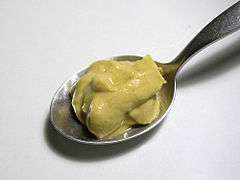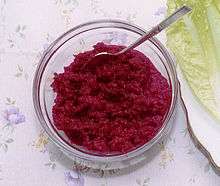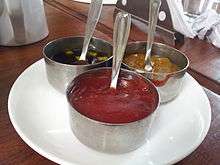Condiment
A condiment or table sauce is a spice, sauce, or preparation (such as onions) that is added to food to impart a specific flavor, to enhance the flavor,[1] or, in some cultures, to complement the dish. The term originally described pickled or preserved foods, but its meaning has changed over time.[2]
Many condiments, such as mustard or ketchup, are available in single-serving packets, commonly when supplied with take-out or fast-food meals. The diner usually applies them, but they are sometimes added prior to serving, for example, in a sandwich made with ketchup, mustard or mayonnaise. Some condiments are used during cooking to add flavor or texture; barbecue sauce, compound butter, teriyaki sauce, soy sauce, and marmite and sour cream are examples.
The term condiment comes from the Latin condimentum, meaning "spice, seasoning, sauce" and from the Latin condere, meaning "preserve, pickle, season".[3]
Definition


The exact definition of a condiment varies. Some definitions encompass spices and herbs, including salt pepper,[4] using the term interchangeably with seasoning.[5] Others restrict the definition to include only "prepared food compound[s], containing one or more spices", which are added to food after the cooking process, such as mustard, ketchup or mint sauce.[5] Cheese is also considered a condiment in some European countries.
History
Condiments were known in Ancient Rome, Ancient India, Ancient Greece and Ancient China. There is a myth that before food preservation techniques were widespread, pungent spices and condiments were used to make the food more palatable,[6] but this claim is not supported by any evidence or historical record.[7] The Romans made the condiments garum and liquamen by crushing the meat of various fish and fermenting it in salt, leading to a flourishing condiment industry.[3] Apicius, a cookbook based on 4th and 5th century cuisine, contains a section based solely on condiments.[3]
List of condiments
Condiment market in the United States
The condiment market refers to the marketing and consumer purchase of condiments.
In the United States, condiment market was valued at USD 5.6 billion in 2010 and is estimated to grow to USD 7 billion by 2015.[8] The condiment market is the second largest in specialty foods behind that of cheese.[8]
Gallery

 Chrain (horseradish sauce)
Chrain (horseradish sauce)



 Ajika, spicy sauce in Caucasian cuisine
Ajika, spicy sauce in Caucasian cuisine
 Packets of duck sauce
Packets of duck sauce


See also
- Condiments by country (category)
- Dip
- Garnish
- List of fish sauces
- List of foods
- List of mustard brands
- Non-brewed condiment
- Seasoning
- Spice
- Relish
- Ingredient
References & sources
References
- ↑ Merriam-Webster: Definition of condiment
- ↑ Smith, pp. 144–146
- 1 2 3 Nealon
- ↑ Collins: Definition Condiment
- 1 2 Farrell, p. 291
- ↑ Farrell, p. 297
- ↑ According to Paul Freedman, the idea is presented as a fact even by some modern scholars, despite the lack of any credible support; Freedman (2008), pp. 3–4
- 1 2 Sax, David (October 7, 2010). "Spreading the Love". Bloomberg Businessweek. Retrieved 9 October 2010.
Sources
- "Collins: Definition Condiment". Collins Dictionary. n.d. Retrieved 29 September 2014.
- Farrell, K. T. (1990). Spices, Condiments and Seasonings (2nd ed.). MA, USA: Aspen Publishers. p. 291. ISBN 9780834213371.
- "Merriam-Webster: Definition of condiment". Merriam-Webster Dictionary. Retrieved October 23, 2011.
- Nealon, Tom (7 September 2010). "De Condimentis". HiLobrow. Retrieved 10 February 2014.
- Smith, Andrew F. (May 1, 2007). The Oxford companion to American food and drink. Oxford University Press. ISBN 978-0-19-530796-2. Retrieved March 15, 2012.

